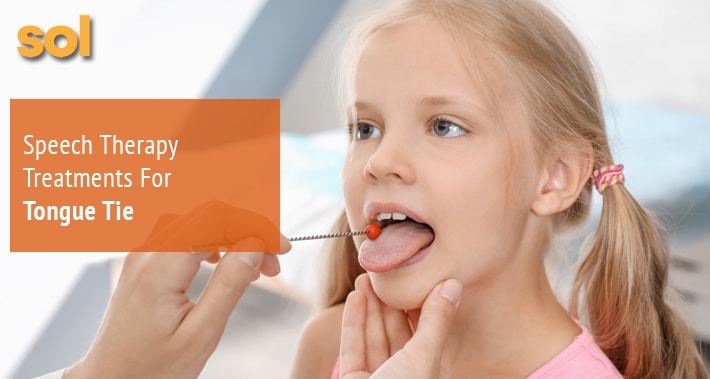
Tongue tie is a common childhood ailment diagnosed in approximately 4% of American children.
It’s referred to as a “congenital anomaly”, meaning it’s a condition which is present at birth.
Tongue tie can significantly impair your child’s ability to use their tongue for skills such as eating, swallowing, and eventually talking.
RELATED: Pediatric Speech Therapy For Feeding And Swallowing Disorders
Depending on its severity, it can also interfere very early with breastfeeding.
Or, you may notice the symptoms later in your child’s life as they have difficulty communicating effectively or lick an ice cream cone.
The good news is that tongue tie is easily treated and any lasting effect on your child’s speaking ability can generally be resolved with speech therapy for children.
At Sol Speech and Language Therapy, we have a special interest in helping children with tongue tie thrive in their various environments.
Now, let’s find out more.
What Is Tongue Tie?
Tongue tie, also called ankyloglossia, is a condition commonly found in newborns.
It’s sometimes confused with tongue thrust, a similar, but different condition.
Tongue tie is a condition which restricts the range of motion in your child’s tongue.
This happens because an unusually short, thick, or tight band of tissue is tying the bottom of their tongue’s tip to the floor of their mouth.
That’s why it’s called tongue tie.
Tongue tie can interfere with breastfeeding, and so if your baby has it, you may know immediately if they are having challenges feeding.
Other times, it is less severe and only interferes with your child’s ability to stick out their tongue past their bottom teeth.
In these cases, diagnosis may not occur until later in life.
Nonetheless, early diagnosis and treatment is important for your child’s future skill development and overall wellbeing.
If left untreated, tongue tie can affect the way your child eats, speaks, and swallows.
How To Tell If Your Baby Has Tongue Tie
The symptoms associated with tongue tie are primarily physical.
If your baby has tongue tie, you might notice that they:
- Have trouble sticking out their tongue past their lower front teeth
- Experience difficulty lifting their tongue to their upper teeth or moving their tongue from side to side
- Have a tongue that appears notched or heart shaped when stuck out
- Display difficulty feeding, including breastfeeding
It’s important to note that while we mention teeth, you can still see these symptoms in your baby if they haven’t developed their teeth yet.
What Causes Tongue Tie?
The direct cause of tongue tie is currently unknown.
However, we know it’s a condition that develops in utero.
Your baby’s tongue was fully formed during the 10th and 11th week of pregnancy.
During this time, the lingual frenulum (tissue underneath their tongue) was also formed.
Look in a mirror, then stick your tongue out, and lift it up as high as you can.
See that band of tissue that connects the bottom of your tongue with the bottom of your mouth?
That’s your lingual frenulum.
In typically developing babies, the lingual frenulum separates prior to birth, which allows your tongue a free range of motion.
With tongue tie, the lingual frenulum does not separate and remains attached to the bottom of your tongue at birth.
Additionally, genetic factors are also thought to play a role in the development of tongue tie.
For instance, a genetic mutation known as the MTHFR mutation is thought to increase your baby’s risk of developing tongue tie and other types of congenital anomalies.
Complications From Tongue Tie
Tongue tie requires a fairly simple treatment, which we’ll explore shortly.
But first, it’s importance to discuss the importance of early intervention.
If left untreated, tongue tie can significantly affect your baby’s oral development.
This includes the way they eat, speak, and swallow.
Fortunately, at Sol Speech and Language, our speech pathologists can help in several ways.
From your baby’s initial speech therapy evaluation to treatment, we’re here to help every step of the way.
Let’s dive into some complications that tongue tie can lead to and how a pediatric speech therapist can help.
Breastfeeding Challenges
Tongue tie can lead to significant breastfeeding challenges.
In order to properly breastfeed, your baby must be able to keep their tongue over their lower gums while sucking.
If they can’t, your baby might chew instead of suck on the nipple.
Beyond this being painful for you, it can also interfere with your baby’s ability to get breast milk.
This is the biggest challenge of tongue tie because poor breast feeding can lead to inadequate nutrition.
RELATED: A Speech Therapist’s Secret To Incorporating Vegetables Into Your Child’s Diet
Inadequate nutrition will interfere with your baby’s ability to thrive as they develop.
Speech Difficulties
Tongue tie can affect your child’s ability to make certain sounds.
RELATED: Understanding The Different Types Of Speech Sound Disorders
These sounds include:
- T
- D
- Z
- S
- Th
- R
- I
Inability to create these sounds can cause a speech sound disorder.
Left untreated, it can also lead to future issues such as bullying, poor self esteem, and mental distress.
RELATED: Can Speech Therapy Help With Anxiety?
Early intervention and speech therapy for articulation disorders can help reduce these risks.
Poor Oral Hygiene
If tongue tie persists into adulthood, it can make it difficult to clean your mouth and teeth from food debris.
It can also lead to the formation of a gap between your bottom two front teeth.
This gap often requires treatment that can be expensive since aesthetic procedures are typically not covered by insurance.
Poor oral hygiene can also lead to tooth decay and the inflammation of your gums, a condition referred to as gingivitis.
Other Challenges Associate With Tongue Tie
Tongue tie can also lead to a variety of other oral challenges.
Some examples include trouble:
- Licking
- Kissing
- Playing a wind instrument
- Whistling
- Singing

How To Treat Tongue Tie
To treat tongue tie, most doctors recommend a simple surgical cut to release the frenulum.
This procedure is called a frenotomy.
If further repair is necessary, or if your lingual frenulum is too thick for a frenotomy, then a frenuloplasty is required.
This is a more extensive procedure.
This work is outside the scope of a speech therapist, however.
Consult with your pediatrician for more information.
How Can Speech Therapy Help With Tongue Tie?
Like we said above, most doctors would recommend a frenectomy to first address the root cause of tongue tie.
This is because the tongue must first have its full range of motion before starting speech therapy.
Prior to this procedure, you may have noticed that your child sounded slushy when making particular sounds.
The level of this slushy sound would vary depending on the degree of tongue tie.
Post surgical treatment, your child may have ingrained some of those habits and sound like they are developing a speech impediment.
That’s where a speech therapist comes in.
If you hear that your child might be developing a speech impediment after their tongue tie has been surgically resolved, the sooner you get the assessed the better.
It will take some retraining, but your child should have a full range of speech and forget those prior bad habits with time.
RELATED: Setting The Record Straight: Debunking Speech Therapy Myths
Book Your Appointment With Sol Speech And Language Therapy Today
As you can see, tongue tie can be a challenging condition if not addressed right away.
The good news is that a frenotomy is a safe procedure with a permanent effect.
After that, if you notice your child has developed a speech impediment as a result of their tongue tie, our team of therapists can help resolve it.
Get started with an initial consultation at one of our Texas clinic locations today.
Book your appointment with Sol Speech And Language Therapy today to hear more about how we can help your child recover from their tongue tie.
6448 E Hwy 290 Suite E-108,
Austin, TX 78723
(512) 368-9488
» https://g.page/r/CfRfhOpEQm7BEAE
Sol Speech & Language Therapy
555 Round Rock W Dr E-221,
Round Rock, TX 78681
(512) 808-3953
» https://g.page/r/Cb5pwCTosSEfEBM
Sol Speech & Language Therapy offers personalized skilled intervention to those struggling with their speech and language skills. Services offered include screening, consultation, and comprehensive evaluation. We also provide one-on-one and/or group therapy for speech sound disorders, receptive/expressive language delay/disorder, stuttering/cluttering, accent reduction, and much more.